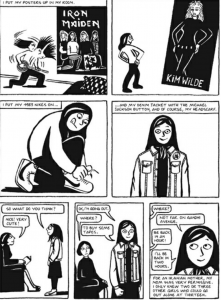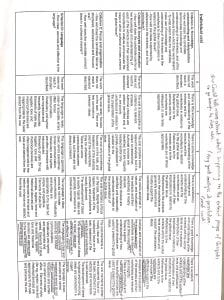Line of inquiry – How does Marjane Satrapi show the change in culture in Persepolis?
The graphic novel “Persepolis” by Marjane Satrapi set between the years 1976 and 1994 during the time of the Iranian Revolution, was really chaotic at that time as everything was changing due to the revolution. The people of the country drastically changed from living as westernised citizens to religiously oppressed people. Marjane Satrapi was only nine years old when the Islamic Revolution started in 1979 where they reintroduced a religious state in Iran.Though she was influenced by western culture that she received from her parents, she still believed in God and trusted him unlike her parents. However, her perception about god changes completely due to different cultural backgrounds that she experiences when she goes to Austria. Furthermore due to governmental and religious power, it led to change in their cultural beliefs and values in the society. Her life changed dramatically under the new regime and they were downtrodden by Muslim fundamentalists who took power. Marjane wrote Persepolis, a graphic novel based on how she spent her childhood in Iran and changes she faced living in another country.
The book being a graphic novel helps Marjane to target the younger generations and help them understand the importance of preserving culture and identity, regardless of external factors. The use of flashback and first point of view effectively portrays the reality that the author had faced as she grew up experiencing different cultures and challenges. Also, a more personal approach is used in order to convey the sorrowful impact of war on freedom. In most parts of the book, including my chosen text (page 131), the angle is eye level and it puts the audience on the same level as the character so that readers can easily understand the author’s situation. On the other hand, the author wrote the book in graphic form where she uses frames of drawing with minimal use of texts and styles; all in black and white as the novel expresses her childhood experiences which was in the past and the use of six – eight panels on a page, so her targeted audience can easily understand. Artistic drawings are also important as the texts in the novel as it shows the culture and the context of that time. However, the images give an overview and understanding of the text and encourages the children (target audience) to read the whole book.
The culture, lifestyle, religion and political factors of the country gradually changed as a result of the Islamic Revolution. Islamic veil symbolises oppression and the limitations imposed on religious people. Thus, in the novel, everyone was not only forced to wear the veil, but also have to follow the Islamic religion and be religious though they are not. The change in their religion changed their culture as what they believe, value and celebrate changed into something they aren’t used to. However, Marjane doesn’t take it seriously most of the time and she often wears the veil in an inappropriate way. For example page 131 (figure 1) , she wears her denim jacket with Michale Jackson button and her headscarf. She even had two posters of western pop singers in her room which were strictly forbidden in Iran during the revolution. This highlights her desire for freedom of dressing and her rebellious state going against the authorities. On the same page, the second row is medium shot and it focuses on the characters interactions and her dialogues. We can clearly identify her western clothes and shoes but she also wears the veil on her head with her some hair in the front. This shows the mixture of culture that the author is facing and she doesn’t know which culture and religion she should actually follow; the organised islamic culture or her private western culture. Keeping her hair loose in the front shows her position and attitude towards the veil. The first row and the last two pictures of third row is a long shot and it stresses the surroundings of the main character with western posters and her mother in the background. Her mother also wears clothes that do not cover her legs which highlights the family’s desire of escaping oppression.
At the beginning, Marjane talks about religion and her interest in becoming a prophet. Deep down, she was really religious and believed in god contrasting with the modernised views of her parents which has some influence on Marajne’s beliefs(page 6) figure 3. The part where Marjane is internally religious and the external religious oppression happening around her portrays religion as either good or bad. Religion is one of the motifs shown throughout the book and it shows the importance of the author’s understanding of her identity and which religion she should follow exactly and whether she still wants to become a prophet. However, after they reintroduced the religious state in Iran, everything changed and Marjane was exposed to a different cultural and religious background which changed her perspective completely.
In Persepolis, one’s physical appearance becomes pivotal. Since women were forced to wear the veil, Marjane was unhappy with the way she had to dress causing the feeling of being imprisoned and oppressed. Page 302 (figure 2) shows how much she is being constricted by the new regime and the loss of her individual freedom. She had to be really careful and always think about how much makeup she can put and whether her clothes are covering all parts of her body. She could no longer ask for her freedom and rights. Thus, in the image she walks away, leaving her second thoughts behind. These factors changed their Iranian culture which eventually led to change in their own identities and behaviours towards the society. The changes in their lives represent the external social phenomenon, while their psychological reactions show the tension, anxiety and unrest triggered by the social disruptions. This also reflects how the revolution influenced peoples’ interiority and identities.
It was not safe in Iran anymore. Those who did not obey the new regimes were systematically arrested and executed; fake votes were made for the acceptance of the new Islamic culture and people were taken to the prison. There was no justice in the society. The change in society’s values and beliefs due to politics completely changed the culture of Iranians. In addition to that, all the universities were shut down in order to open new universities with all the Islamic system and curriculum. The government recruited Islamic teachers at schools; children were taught how to pray in Islamic religion and they were forced to mourn for the dead people at the war by beating on their chest twice a day. Iran’s school systems were slowly changing into Islamic system. On the other hand, those women who do not wear their veil properly were told that they will be sexually assaulted by the beard men of Islam and throw them into the garbage. Marjane’s parents got worried about her so they sent her to Austria to study and live there safely. However, this changed her completely as she was exposed to different cultural backgrounds.
Marjane was open to the various cultural backgrounds and she made friends with different people who had different perspectives and lifestyles. She also stayed in several frustrating relationships which brought her to change her own personality just to fit into that society and be loved by her people around her. While her friends had sex and kisses with many boys which was a normal thing in their culture. Marjane gets culture shock as she spent more time in Austria with her friends since she came from a very preserved family in Iran. She tries to change herself and follow their culture which is not hers. At the end, Marjane dives into an unexpected path and gradually loses herself.
Though Marjane was physically free in Austria, she was never internally free. She was anxious and worried about her family in Iran. Due to the revolution, Iran was collapsing and slowly coming under Islam where Marjane thinks that she is also losing her Iranian culture and identity. Thus, Marjane started lying to her friends about her nationality. On page 195, she pretends to be French in front of her other friends and says that “to be Iranian was a heavy burden to bear”. She realizes what her grandmother told her about being true to yourself and keeping your dignity and feels guilty for distancing herself intentionally from her Iranian culture and identity. Marjane doesn’t really accept her true identity unless she finds people judging and talking bad about her identity in a cafe. On page 197, she shouts at them “I AM IRANIAN AND PROUD OF IT!” all in capital letters with an exclamation mark at the end, where she accepts her Iranian identity completely. Though she accepts her identity as Iranian, her culture changed. She had to follow the organised Islamic religion and culture in Iran, whereas, she followed her free culture in Austria where there were no restrictions and limitations.
In conclusion, through Persepolis, Marjane intends to remind the readers of the precarity of survival in political and social situations. The external factors like religion, politics, society values can change one’s culture, thus the author intends to empower women and remind the readers that we cannot change the truth or things that are created by superiors but being true to ourselves no matter how the situation changes is what is important to every individual.
Figure 1 Figure 2

Figure 3
Page 131









